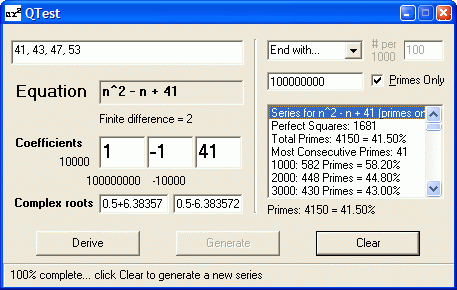home
Attention Math Students:
This topic is not related to
the Q test used in statistics.
How to Use QTest
QTest is a versatile tool for deriving and analyzing quadratic expressions, generating integer sequences, and determining their primality.
Download here

Derive
To derive a quadratic equation (that is, find its coefficients) and solve* it:
Enter 3 or 4 terms and click Derive.
Notes:
-Use four terms to verify a finite 2nd degree polynomial.
-Data can be comma- or space-delimited - or can be a standard list (with line breaks).
-You can also enter an equation or coefficients directly. (If you enter an equation directly, click A.)
* Although it's not the primary purpose of QTest, solving a quadratic equation means finding its roots - where the parabola of the number sequence intersects the X axis in the Cartesian plane. (Complex roots mean there are no X intersects - therefore, the intersects are imaginary.)
Generate
Select a range for the generated sequence and other options for generating terms from the expression:
-End with* or Start from n =specified number or Random to* or Random from n =specified number. For a random range, select the sampling frequency (between 25 and 975 per 1,000 values of n).
-Uncheck Primes only to generate composites also (in which case primes are denoted by a P suffix).
-To interrupt, press Esc. (Required for Start from and Random from to stop).
*Beginning with n=0.
Clear
Clears most data, but leaves the quadratic and coefficients, and enables Generate.
Shortcut Keys (Press Letter Key Only)
Esc = Stop processing, summarizing results so far, and enabling Clear key.
Q = Copy sequence (first 10 terms) to Clipboard
S = Populate terms box with generated sequence
C = Copy complete generated data to Clipboard
E = Copy equation to Clipboard
A = Populate coefficients from equation
Ctrl with Generate = Save data to file in QTest.exe's folder (Generate tooltip shows filename)
O with Generate = Shows in parentheses the offset from the pronic sequence (2, 6, 12, 20, 30, 42, ...)
N = Copies the selected generated value and the following 3 values into the terms box.
The following steps will generate an analysis of successive quadratic sequences derived from proximate primes, like this:
1. Start and allow caching to finish, then click Derive to enable Generate key.
2. Press P and click Generate to analyze proximate primes up to 1,500, or enter your own range, using a dash, less than 100,000 (for example, 45000-53000).
3. Press G to bulk generate analysis for quadratic expressions.
Additional switches:
X = Calculate real roots by using absolute discriminants (inverting parabolas with complex roots).
D = Include non-quadratic expressions - results for these will not be valid unless linear (for example, 2n + 1)
4. Press C to copy from results window.